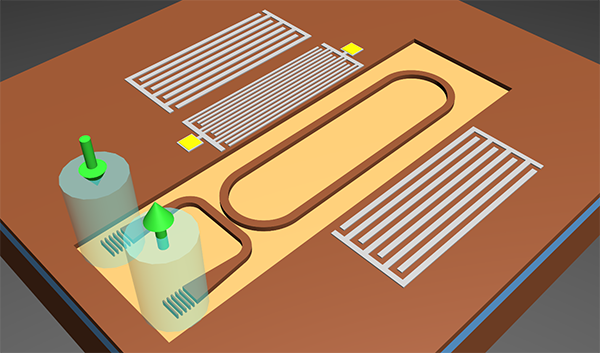Acousto-optic (AO) effect, which describes the interaction between light and sound waves, is extensively used to build up frequency shifter, tunable filter and light beam deflectors, leading to applications including laser Q-switching/mode-locking, signal processing and manipulation of light beams. Among all the acousto-optic active materials, lithium niobate (LN) is one of the most attractive materials because of its high piezoelectric coefficients enabling efficient generation of surface acoustic waves (SAW) through interdigital transducer (IDT) technology. Compared with the state-of-art AO modulator fabricated on other piezoelectric materials such as GaAs, LN exhibits a higher electromechanical coupling coefficient, which dramatically simplifies the design of SAW devices and facilitates matching to radio frequency (RF) driving sources in a much smaller form factor. In addition, the strong photo-elastic effect enables efficient photon-phonon interactions in such material. These properties have made LN one of the most promising materials for realizing integrated AO devices for inertial sensing, holographic storage/imaging and beam steering applications. However, conventional AO devices built on bulk LN wafers suffer from the limited AO interaction due to the weak light confinement in waveguide structures created by titanium-indiffusion and proton exchange methods. Typical waveguide mode size is in the dozens of square micrometers (μm2), and the bend radius on the order of centimeters, resulting in relatively large device footprint and hindering high density integration.
In the past two decades, lithium niobate on insulator (LNOI, thin film lithium niobate bonded on a low refractive index substrate or buffer layer) has emerged as a promising platform for integrated optics due to its high index contrast stack layer structure. Thanks to the persisting effort made in fabrication methods and processes, low-loss waveguides and high-Q resonators have been demonstrated and a variety of photonic devices with high performance and small footprint have flourished in recent years. Investigating the thin film LN AO properties and forming highly efficient AO modulation devices are essential to develop next generation of AO devices/applications in LNOI.
To confirm the feasibility of the new thin film LN approach, Dr. Lutong Cai and Prof. Gianluca Piazza from the Department of Electrical and Computer Engineering at Carnegie Mellon University carried out the first proof-of-concept work of implementing AO modulation devices in LNOI. This work is published in Photonics Research, Volume 7, No. 9, 2019 (L. Cai, et al., Acousto-optical modulation of thin film lithium niobate waveguide devices).
The LNOI AO modulator consists of IDTs (generating SAW), two acoustic reflectors forming a photonic cavity, and photonic waveguide devices. All the components are fabricated and monolithically integrated on a 500 nm thick film of lithium niobate. The thickness of the insulating oxide below the LN is chosen to be 1.5 μm, so as to achieve a good trade-off between the waveguide loss and SAW electromechanical coupling. In fact, as a thicker oxide layer lowers the waveguide loss, it deleteriously impacts the SAW devices. AO interactions are enhanced by forming standing SAWs inside a photonic cavity. The optical waveguide, which is now a very small fraction of the acoustic wave, is placed at the maximum strain/stress locations to attain strong AO modulation through photo-elastic effect. The SAW and waveguide mode propagation directions are optimized in such a way that the refractive index change is maximized while kept uniform along the waveguides. Two grating couplers are used to couple light to/from the chip as well as facilitate future integration with on-chip lasers and detectors. The photo-elastic coefficient of thin film lithium niobate is extracted by measuring modulation signals of different orders in a Mach-Zehnder interferometer, indicating that LNOI preserves the excellent acousto-optical properties of bulk lithium niobate (LN). Such material property study is of paramount importance in guiding the design of any AO and optomechanical systems. By harnessing the good AO properties, a great wealth of other AO devices can be built to outperform existing counterparts made in bulk LN. The researchers also showcase that the efficient AO interaction can be implemented in a high-Q racetrack resonator (> 300,000), exhibiting loss as low as 0.7 dB/cm, to further enhance the modulation strength with a gain up to 10 dB (compared with Mach-Zehnder type).
Different from the high-bandwidth electro-optical modulators demonstrated in LNOI that are used in broadband communication networks, the MHz AO modulators demonstrated in this work have a wealth of different and impactful applications including inertial sensing (which favors low frequency), holographic storage/imaging, and light beam steering (applications like Lidar). In addition, the strong regulation of optical signal in a high-Q resonator showcased in this work has enormous potential for on-chip stimulated Brillouin scattering (SBS) applications and broadband frequency comb generation.
Prof. Gianluca Piazza believes that this technology will be extremely attractive for the development of new classes of miniaturized and integrated devices that address emerging challenges in wireless and optical communication, classical computing, artificial intelligence, and quantum information science.
Future work will focus on the 3D integration of vertical-cavity surface-emitting laser (VCSEL) and photodetectors onto the AO modulators and extending its operation to high frequency and bandwidth modulation for light beam steering.

Schematic diagram of the acousto-optic modulator. The split interdigital transducers, acoustic reflectors, and photonic waveguide devices are monolithically integrated on the thin film lithium niobate.


